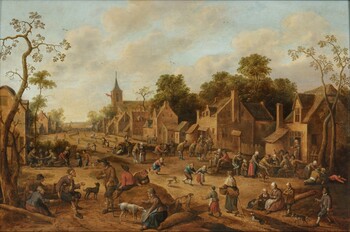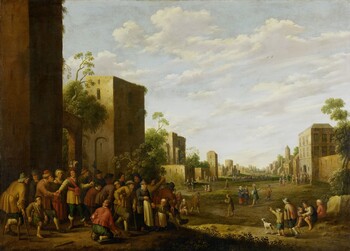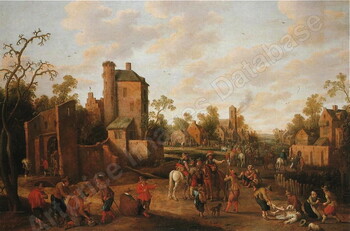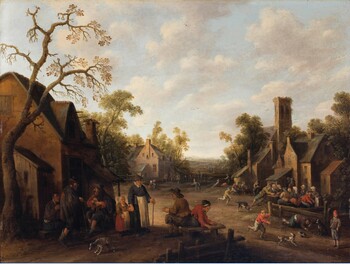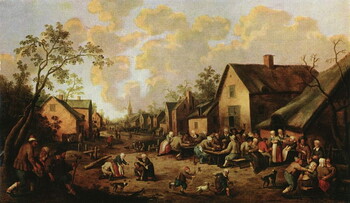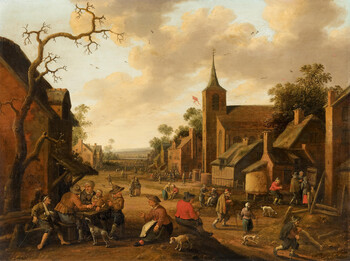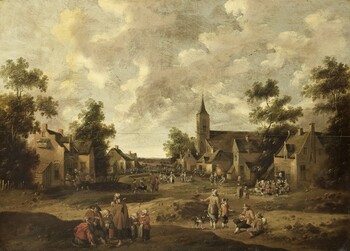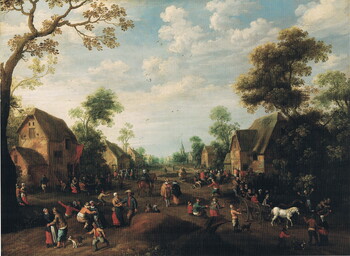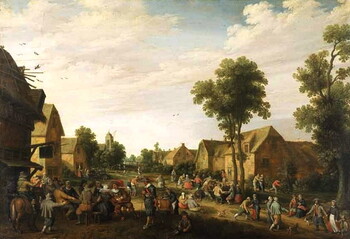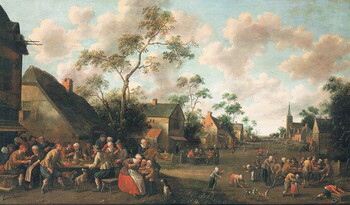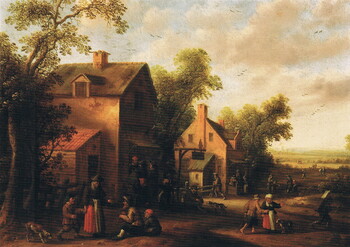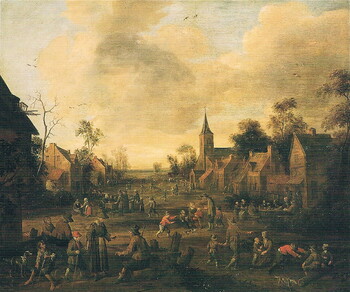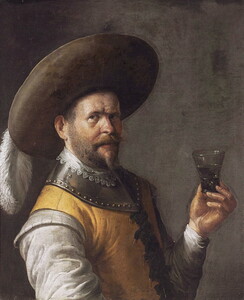6.000 €
A peaceful village street
Oil on panel : 45,5 X 61,4 cm
Monogrammed and dated lower left “JC DS. 1648”
(the JC and the DS are intertwined)
Frame : 64,8 X 80,7 cm
In short
Our idyllic painting is an ode to peaceful, rural life in a small village. It dates from 1648; at the start of that very year the Peace of Münster ended the Eighty Years’ War between Spain and the Dutch Republic.
Droochsloot was a very productive painter who sadly, from the early 1630s onwards, often repeated the same subject: a village street with beggars and infirm people. This reflected his own strong social involvement in his local society of Utrecht.
About Joost-Cornelisz. Droochsloot
Dutch painter
Utrecht 1586 – 1666 Utrecht
Painter of genre scenes, usually with peasants, village and town views and landscapes (including some winter landscapes) and a few religious and allegorical subjects (mostly at the start of his career).
It is not known whom our painter studied under. Seeing the Flemish character of his oeuvre some scholars think he might have studied in Flanders, in Antwerp.
Droochsloot remained in Utrecht his whole life, except for a period at the start of his career: his earliest painting, dated 1615, was made at The Hague, but from 1616 onwards he was back in Utrecht. That year was his first inscription as a member of his birthplace Painter’s Guild of Saint Luke. He was its Dean in 1623, 1641 and 1642.
Master of six pupils: best known are his own son, Cornelis Droochsloot (1640 – after 1673), and Cornelis Duck (circa 1600 – 1667, painter of genre scenes, regularly with military).
Droochsloot died in 1666, one year after his wife, Agnieten van Rijnevelt. The couple had at least eleven children, but all of them, except for the painter Cornelis, died before them. Actually, Cornelis married May 3rd 1666, with his father as his witness, who died just a few days later (he was buried the 14th). Three of the children of Joost-Cornelisz. and Agnieten died from the plague in 1636. In five years time, of which 1636 was clearly the worst, at least 4300 inhabitants of Utrecht died of it, almost 15% of the total population of some 30.000 inhabitants. And then one does not take into account other killing diseases, such as cholera.
Our painter’s first name should be pronounced Joost-Corneliszoon. The “z.” at its end stands for “zoon”, “son”.
About our painting
Droochsloot was a versatile and productive painter. The Central Museum of his hometown Utrecht holds 15 of his paintings, showing the diversity of his work.
On the other hand Droochsloot is also known for the repetitive character of his artistic production, regularly repeating diverse variations in all dimensions of his most successful composition: a village street with houses on both sides with many inhabitants and beggars, sometimes including the Seven Act of Mercy.
One should see the choice for this subject against the background of his own social involvement in his community:
- in 1638 he was elected regent of the Saint Job’s hospital, along the Vleutenseweg, a function that he kept until his death. During the 16th century it had mainly cared for male syphilis patients, but it slowly evolved into a retirement home.
The Painter’s Guild of Saint Luke of Utrecht was established in one of the rooms of that Hospital. During the 17th century it was a habit that each year a local artist would offer a painting to this almshouse, which would then be hung in the Regent’s room. Droochsloot had done so in 1628: a landscape with the consolation of Job’s friends.
- in 1642 Droochsloot became deacon of the Dutch Reformed Church.
About the important date of our painting
Our painting dates from 1648. This was a very important year for the Dutch: January 30th a peace treaty was signed in Münster that ended the Eighty Years’ War between Spain and the Dutch Republic.
Why should you buy this painting?
Because it is a nice, animated village scene, an ode to Peace after eighty years of war which had often ravaged the Dutch countryside.
Comparative paintings
Click photos for more details

